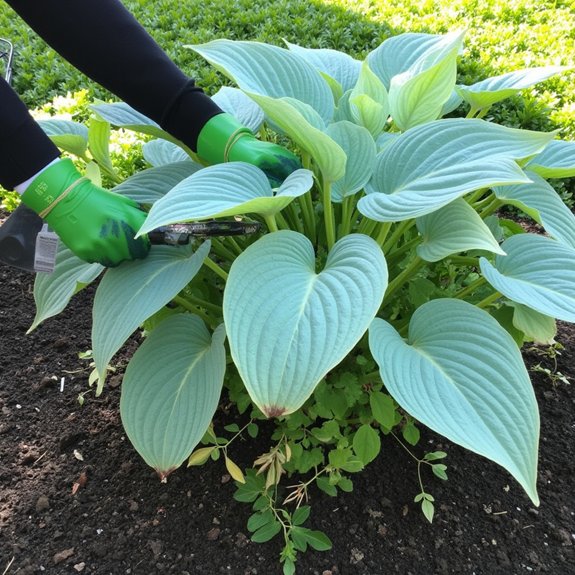When Sarah transplanted her ‘Blue Angel’ hostas last spring, she discovered they’d lost their distinctive blue hue and turned green within months. You’re probably wondering how she could’ve prevented this color change, especially since blue hostas can cost $15-50 per plant. The secret lies in understanding why these plants develop their coveted blue coloration and what environmental factors can either preserve or destroy it. Master these specific techniques, and you’ll avoid Sarah’s costly mistake while creating the stunning blue garden display you’ve envisioned.
Contents
- 1 The Rich History and Origins of Blue Hostas
- 2 Understanding the Ornamental and Culinary Value
- 3 Effective Propagation Techniques for Healthy Growth
- 4 Best Practices for Planting Blue Hostas
- 5 Essential Care and Maintenance Requirements
- 6 Soil Preparation and Fertilizing Guidelines
- 7 Managing Temperature and Environmental Conditions
- 8 Preserving the Blue Color and Long-term Plant Health
The Rich History and Origins of Blue Hostas

Centuries ago, blue hostas began their remarkable journey in the mountainous regions of China, where wild varieties still flourish today. These plants spread naturally to Korea, Japan, and Russia, earning native status through centuries of adaptation.
Japan’s historical cultivation transformed these humble plants into garden treasures. Traditional Japanese gardens embraced hostas, developing new cultivars that enhanced their cultural significance in landscape design.
Everything changed when Philipp Franz von Siebold introduced them to Europe in the early 19th century. This pivotal moment sparked thousands of cultivars, each showcasing that coveted blue hue you’re seeking for your garden today.
Understanding the Ornamental and Culinary Value
Beauty meets function when you discover blue hostas serve dual purposes in your garden space. The ornamental benefits are obvious – these plants create stunning shade coverage under trees, mimicking tropical aesthetics with their distinctive blue-tinted foliage. You’ll find they’re perfect for filling those challenging shady spots where other plants struggle.
However, culinary uses might surprise you. Young hosta leaves taste remarkably similar to asparagus, making them excellent additions to Japanese dishes. You can harvest tender leaves throughout the growing season, and don’t overlook the flowers – they make beautiful, edible salad garnishes.
Effective Propagation Techniques for Healthy Growth

Now that you understand blue hostas’ versatility, you’ll want to multiply your collection through proven propagation methods. Division techniques offer the most reliable approach, with spring and early summer providing ideal timing when new buds emerge.
Start by carefully lifting established clumps, then separate sections with sharp, clean tools. Each division needs healthy roots and several growing points. Plant immediately in loose, organic-rich soil, spacing according to mature size specifications.
While seed propagation and leaf cutting remain options, division consistently delivers superior results. Fall division works too, but complete it before the first frost arrives.
Best Practices for Planting Blue Hostas
Success with blue hostas starts at planting time, when proper placement and soil preparation set the foundation for decades of growth. You can plant these perennials anytime, but spring and autumn offer the best establishment conditions.
Check plant labels for mature size before digging, as plant spacing varies dramatically between varieties. Dig holes wider than deep to encourage outward root growth, then enrich the soil with organic matter for improved drainage and nutrition.
After planting, apply mulch to retain moisture and suppress weeds. Your watering frequency should be twice weekly initially, adjusting for rainfall patterns.
Essential Care and Maintenance Requirements

Once your blue hostas are established, maintaining their vibrant color requires understanding their unique lighting needs. They’ll thrive in dappled shade under trees, tolerating cool morning sun but fading if exposed to harsh afternoon light.
Your watering techniques should focus on deep, direct soil application twice weekly initially, then once established, water deeply once per week. Avoid overhead watering that washes away the blue coating.
For pest management, monitor regularly for slugs and snails that target tender leaves. Apply organic mulch to retain moisture while suppressing weeds. These low-maintenance perennials reward minimal intervention with decades of beauty.
Soil Preparation and Fertilizing Guidelines
While proper lighting and watering establish your hostas’ foundation, soil preparation determines their long-term success and vibrant blue coloration. You’ll want slightly acidic soil with a pH just below 7, enriched with organic matter for ideal drainage and aeration.
Mix compost or well-aged manure into your planting area as key soil amendments. These improve water retention while preventing waterlogged conditions that damage roots.
Fertilizing requirements stay minimal in quality soil. Apply slow-release fertilizer once in spring, or use monthly balanced liquid fertilizer during growing season. Avoid fall fertilizing to prevent growth before dormancy.
Combine proper soil amendments with direct watering techniques to maintain that coveted blue coating.
Managing Temperature and Environmental Conditions
Because blue hostas evolved in temperate Asian climates, they’re naturally cold-hardy plants that actually require winter temperatures below 40°F to enter proper dormancy. Without this cold period, they won’t thrive the following season. You’ll notice leaves die back completely in winter, which is perfectly normal.
However, they’re less tolerant of extreme heat and temperature fluctuations during growing season. When summer temperatures soar, increase watering frequency to keep roots cool and leaves hydrated. Plant them under trees or structures that provide natural protection from environmental stressors like harsh winds, hail, or prolonged direct sunlight that can fade their distinctive blue coating.
Preserving the Blue Color and Long-term Plant Health
The stunning blue color that makes your hostas so distinctive isn’t actually blue pigment, but rather a waxy glaucous coating that reflects light in a special way. For ideal color retention, you’ll need to protect this delicate coating from damage. Avoid overhead watering, which washes away the protective layer, and use drip irrigation instead.
Plant your hostas under natural covers like trees to shield them from prolonged rainfall. Direct watering at soil level maintains the blue sheen while keeping roots properly hydrated.
With proper leaf protection techniques, your hostas will maintain their gorgeous blue appearance for years, creating lasting garden beauty.
